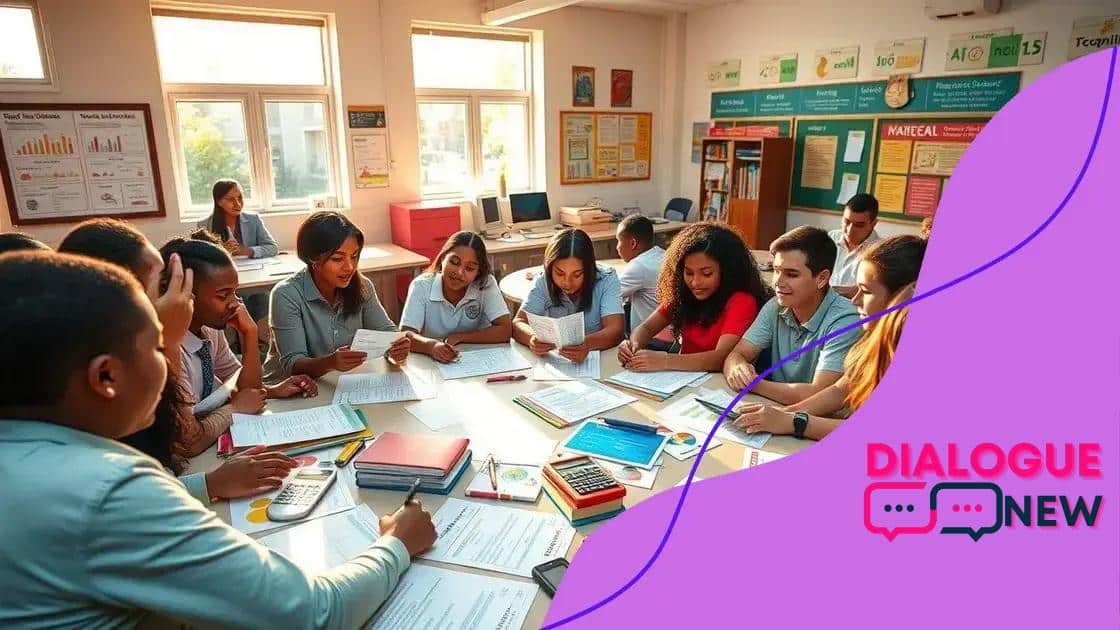Financial literacy education in schools: a necessity

Financial literacy education in schools equips students with essential money management skills, enhancing their ability to make informed financial decisions and fostering long-term financial responsibility.
Financial literacy education in schools plays a vital role in preparing students for real-world financial decisions. Have you ever wondered how understanding budgeting, saving, and investing could impact a young person’s future? Let’s dive into its significance.
Understanding financial literacy: what does it mean?
Understanding financial literacy is crucial for making informed decisions about money. But what exactly does this term mean? Simply put, financial literacy refers to the ability to understand and manage your finances effectively. This involves skills such as budgeting, saving, investing, and comprehending financial products.
Knowing how to navigate the financial landscape can empower individuals, especially young students, to take control of their economic future. It helps them avoid pitfalls such as debt and poor investment choices. Let’s explore this concept further.
The key components of financial literacy
Financial literacy consists of several core elements that everyone should understand:
- Budgeting: Creating a plan for how to spend money wisely.
- Saving: Setting aside money for future needs or emergencies.
- Investing: Growing money by putting it into stocks, bonds, or other opportunities.
- Understanding credit: Knowing how credit works and its impact on financial health.
Each of these components plays a vital role in ensuring a sound financial future. Without a strong grounding in these areas, young individuals may struggle when facing real-world financial decisions. It’s essential to build a knowledge base from an early age.
Why is financial literacy important?
Comprehending the basics of finance helps students develop a mindset that prioritizes financial responsibility. It fosters a culture where young people think critically about their expenses and savings. Furthermore, by integrating financial literacy into the school curriculum, we equip students with tools they need to succeed.
Imagine a high school graduate who understands the implications of student loans versus scholarships. They are more likely to make informed choices about their education and future investments. When financial literacy education is emphasized, students can visualize their financial paths more clearly.
As we consider ways to implement financial literacy education in schools, it is essential to keep these concepts at the forefront. By doing so, we prepare students not only for immediate financial challenges but also set a foundation for long-term success. Understanding financial literacy can lead to empowered individuals who are ready to make sound economic decisions.
The importance of teaching money management in schools
The importance of teaching money management in schools cannot be overstated. As young students prepare to enter adulthood, having a solid foundation in financial skills is essential. Money management allows individuals to handle their finances responsibly and make informed decisions about spending and saving.
One way to understand this importance is to look at the long-term effects of being financially savvy. Students who are taught these critical skills are less likely to fall into debt and more likely to achieve their financial goals. By equipping students with the knowledge they need, schools can pave the way for a financially stable future.
Benefits of teaching money management
Integrating money management lessons into school curricula results in several significant benefits:
- Empowerment: Students gain confidence in managing their finances.
- Better decision-making: Understanding money helps students make informed choices.
- Positive habits: Learning to save early fosters strong financial habits.
- Preparation for real life: Financial education equips students for adulthood.
By emphasizing these points, educators highlight how vital it is for students to learn about money. Furthermore, practical application is crucial. Lessons should include hands-on activities to deepen understanding.
Real-world applications of financial education
Applying money management skills in real-world situations reinforces learning. For example, students can participate in budgeting exercises, where they allocate money for various expenses. This practice helps them grasp the constraints of real-life financial scenarios.
Moreover, projects such as planning a small business can offer valuable lessons in income and expenses. When students see the direct impact of their financial decisions, they are likely to appreciate the significance of financial education further.
In conclusion, teaching money management in schools prepares students for success beyond the classroom. It instills life skills necessary for making sound financial decisions. By empowering students with these skills, we help shape a financially literate generation.
Practical ways to integrate financial education

Integrating financial education into schools is essential for building a foundation of financial literacy. There are many practical ways to integrate financial education seamlessly into the existing curriculum. Educators can choose methods that engage students and make learning about finance enjoyable.
For instance, interactive workshops can provide students with hands-on experience in managing money. These workshops can cover topics like budgeting, saving, and investing. Once students learn the basics, they can apply this knowledge in real-world scenarios.
Incorporating financial concepts in daily lessons
One effective approach is to weave financial concepts into everyday subjects. Mathematics classes can involve exercises that focus on percentages and interest rates, enhancing students’ practical math skills while introducing finance. Similarly, social studies lessons can discuss economic principles, showing how these concepts affect society.
- Math exercises: Use real-life scenarios to teach percentages, budgeting, and interest calculations.
- Class discussions: Explore the impact of financial decisions on communities and individuals.
- Group projects: Create a mock business that includes budgeting and financial forecasting.
- Guest speakers: Invite financial experts to share experiences and insights with students.
Utilizing technology can also enhance financial education. Online resources and apps allow students to simulate investment scenarios or manage virtual budgets. These interactive tools make learning more engaging and relevant.
Experiential learning opportunities
Another way to integrate financial education is through experiential learning opportunities. Schools can organize field trips to local banks or financial institutions. These trips can help students see how financial systems work in their communities. Understanding banking practices, loans, and savings accounts will make concepts more tangible.
Additionally, school events like a mock stock market day can allow students to experience trading and investment firsthand.
By integrating financial education into various subjects and activities, we can ensure students not only learn important concepts but also apply them intelligently in their lives. This approach prepares young individuals for future financial challenges and fosters greater confidence in their financial decision-making abilities.
Challenges in implementing financial literacy programs
Implementing financial literacy programs in schools comes with several challenges. Understanding these obstacles helps educators devise effective solutions. Many schools recognize the importance of teaching financial literacy, yet they face barriers that can hinder progress.
One challenge is the lack of trained teachers. Not every educator feels comfortable with financial topics. This can lead to inconsistent education across different classrooms and grade levels. It’s vital for schools to provide adequate training for teachers, ensuring they have the confidence to teach financial concepts effectively.
Curriculum constraints
Another significant challenge is fitting financial literacy into an already packed curriculum. Schools often prioritize subjects like math, science, and language arts, leaving little time for additional topics. Educators must find creative ways to integrate financial literacy into existing classes, often requiring curriculum adjustments.
- Time limitations: Balancing financial education with core subjects can be tough.
- Resource allocation: Schools may lack the necessary materials or funding.
- Standardized testing: Focus on test scores can limit exploration of financial topics.
- Community support: Engaging parents and the community is crucial but can be challenging.
Additionally, school funding plays a vital role. Many schools lack the financial resources to develop comprehensive financial literacy programs. Budget cuts often lead to sacrificing important educational initiatives. Without adequate funding, it’s difficult to create engaging and effective financial education experiences.
Student engagement and interest
Another challenge is generating student interest in financial topics. Young learners may find finance dull or irrelevant to their lives. To overcome this, schools must present financial topics in a relatable and exciting way. Using interactive activities, real-life examples, and practical applications can help capture students’ attention.
Finally, measuring the effectiveness of financial literacy programs can be challenging. Schools need to assess whether students are genuinely learning and applying what they’ve learned. Developing suitable evaluation methods requires time and expertise, which can be in short supply.
By recognizing these challenges, we can work toward overcoming them and ensuring that financial literacy becomes an integral part of education. Tackling these issues head-on will lead to more effective financial education in schools.
Success stories in schools with financial literacy curricula
Success stories in schools that have implemented financial literacy curricula showcase the positive impact of such programs. Many schools across the country have made remarkable strides in teaching students essential financial skills. These stories highlight how effective financial education can transform students’ relationships with money.
In one instance, a middle school in California integrated a financial literacy program into its math classes. This addition allowed students to learn about budgeting and saving in a hands-on way. As a result, they created personal budgets based on hypothetical allowances. Students reported feeling more confident about their money management skills, which is crucial for their adult lives.
Creating community partnerships
Another school success story involves a high school in Texas that partnered with a local bank to offer financial education workshops. The bank provided guest speakers and resources, making lessons more engaging and relevant. Students participated in mock investment challenges, where they learned about stocks and trading. This partnership not only enhanced students’ understanding but also fostered a sense of community involvement.
- Improved engagement: Students were excited to learn about money topics.
- Real-world application: Workshop activities connected classroom learning with real-life scenarios.
- Community support: Local businesses contributed resources and expertise.
- Enhanced decision-making: Students reported using their knowledge in everyday financial choices.
Additionally, a school district in Florida implemented a district-wide financial literacy initiative. This initiative trained teachers to effectively deliver financial content across subjects, ensuring consistency in education. The results were outstanding, with students demonstrating higher levels of financial knowledge and confidence.
Measurable outcomes
Many of these schools track success through surveys and assessments. Students show significant improvement in their financial understanding before and after participating in these programs. Surveys indicate that students feel prepared to handle personal finances, including saving for college and understanding credit.
By sharing these success stories, we inspire other schools to consider the benefits of incorporating financial literacy into their curricula. Real-life examples motivate educators, parents, and communities to invest in financial education for the next generation. These programs lead to more informed and responsible financial decisions among students.
In conclusion, integrating financial literacy into school curricula is essential for preparing students for their futures. Through engaging programs, students can learn valuable money management skills that empower them to make informed decisions. Many successful stories highlight the positive impact of these programs, showing significant improvements in students’ financial understanding and confidence. By overcoming challenges and embracing creative solutions, schools can ensure that financial education becomes a fundamental part of learning.
FAQ – Frequently Asked Questions about Financial Literacy in Schools
Why is financial literacy important for students?
Financial literacy is important for students as it equips them with essential skills to make informed decisions about money, fostering responsibility and independence.
What are some successful examples of financial literacy programs?
Successful programs often include interactive workshops, community partnerships with local banks, and integration of financial concepts into existing subjects, showing measurable improvements in students’ financial understanding.
What challenges do schools face in implementing financial literacy education?
Challenges include lack of trained educators, the need to fit financial education into crowded curricula, limited funding, and generating student interest in financial topics.
How can schools engage students in financial education?
Schools can engage students by using real-life examples, interactive activities, and practical applications, such as budgeting exercises and mock investment challenges.





